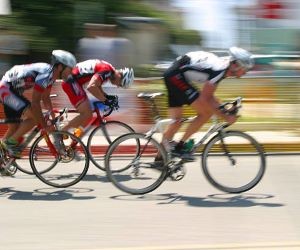Learn how to deal with punctures on long rides with prevention tips, repair techniques, and smart gear choices to keep rolling without stress.
HOW DO I PREVENT LOWER BACK INJURIES IN CYCLING?
Lower back pain is one of the most common complaints among cyclists, often caused by poor bike fit, weak core muscles, or improper posture over long rides. Preventing lower back injuries requires a proactive approach that combines ergonomic setup, mobility training, and recovery strategies. In this article, we explore the root causes of lower back pain in cyclists and provide actionable, science-backed solutions for pain-free riding. Whether you're a weekend rider or a seasoned racer, these habits will keep your spine strong and your performance consistent.

Why cyclists suffer from back pain
The repetitive strain of riding posture
Cycling forces the body into a flexed position for extended periods, often with minimal core engagement or variation in movement. The lumbar spine bears the load as you lean forward, placing repetitive stress on spinal discs, muscles, and ligaments. Over time, this can lead to inflammation, fatigue, or injury.
The static posture of road cycling, especially during long-distance rides, also limits blood flow and increases muscular tightness in the lower back and hips—contributing further to discomfort and dysfunction.
Common contributors to lower back injuries
Most back injuries in cyclists are not caused by acute trauma but by a combination of poor mechanics and overuse. Recognizing these patterns can help you prevent injury before it starts.
Poor bike fit: saddle too high, bars too low, or incorrect reach
Weak core and glute muscles unable to stabilize the pelvis
Limited hip mobility and tight hamstrings pulling on the pelvis
Overtraining without adequate recovery or variation
Lack of post-ride stretching or muscular maintenance
Understanding these root causes allows for a more focused and preventative training strategy.
Bike fit and posture corrections
Optimizing your bike setup
A proper bike fit is the foundation of injury prevention. When your bike is aligned with your body, pressure is distributed evenly and muscular imbalances are minimized. Getting a professional bike fit can significantly reduce lower back stress by ensuring optimal saddle height, reach, and handlebar drop.
Saddle height: Too high causes pelvic rocking; too low increases lumbar strain
Handlebar reach: Overreaching overstresses the spine
Cleat position: Misalignment affects pedaling symmetry and back loading
Use of spacers or shorter stems can reduce aggressive angles
Seat tilt: Slight downward tilt may reduce lumbar tension
Even small adjustments can have major impacts on comfort and performance. Revisit your fit annually or after major training changes.
Maintaining good posture while riding
Proper cycling posture supports spinal alignment and distributes muscular effort efficiently. Focus on keeping a neutral spine—not overly arched or flexed—and engage your core lightly throughout the ride.
Your shoulders should be relaxed, elbows slightly bent, and your head in line with your spine—not craned forward. Adjust your riding position periodically, especially on longer rides, to avoid static loading on the lower back.
Training yourself to maintain posture, even under fatigue, is a learned skill that pays off in long-term spinal health.
Core strength and recovery routines
The cyclist’s core: More than abs
A strong core stabilizes the pelvis and spine, reducing compensatory strain on the lower back. For cyclists, the core includes not just the abs but also the obliques, deep stabilizers, glutes, and lower back muscles. These work together to support posture, power transfer, and control on the bike.
Plank variations (front, side, reverse)
Glute bridges and single-leg bridges
Bird-dog exercise for spinal control
Dead bug for coordination and control
Pelvic tilts to build lumbar awareness
Just 10–15 minutes, 3–4 times per week, is enough to build a bulletproof cycling core.
Stretching and mobility essentials
Stretching post-ride is critical to undo the tightness created by long periods in the saddle. Focus on hip flexors, hamstrings, glutes, and lower back. Dynamic mobility work off the bike—like yoga or foam rolling—can also maintain tissue quality and reduce injury risk.
Lunge stretch for hip flexors
Pigeon pose for glutes
Seated forward fold for hamstrings
Child’s pose and cat-cow for the spine
Foam rolling quads, glutes, and lumbar area
These simple tools can dramatically increase comfort and reduce recurring back issues if used consistently.
Rest, cross-training, and recovery days
Your lower back won't heal or strengthen without rest. Build in recovery rides, complete rest days, and cross-training like swimming or hiking to reduce spinal loading. These also help break repetitive motion patterns and develop balanced muscular support.
If you experience persistent back discomfort, seek help early—sports chiropractors or physiotherapists can identify subtle imbalances and suggest corrective protocols before things worsen.
YOU MAY ALSO BE INTERESTED






